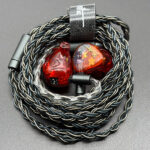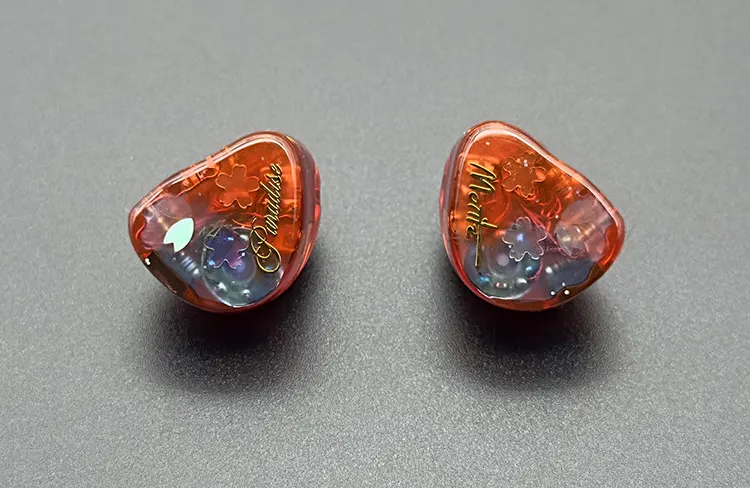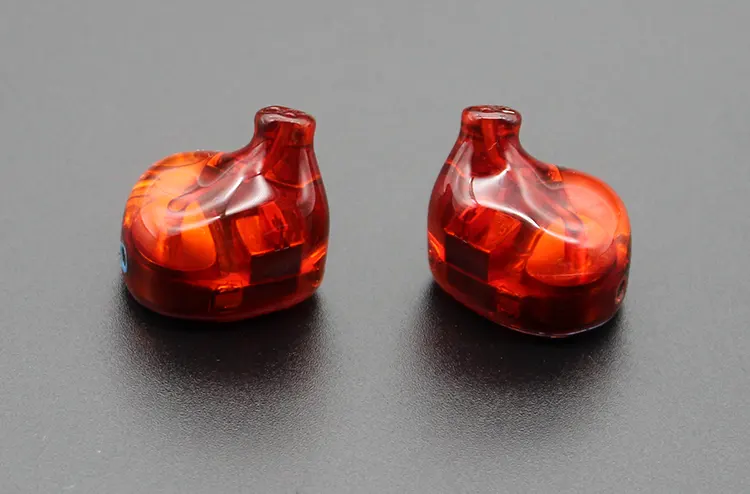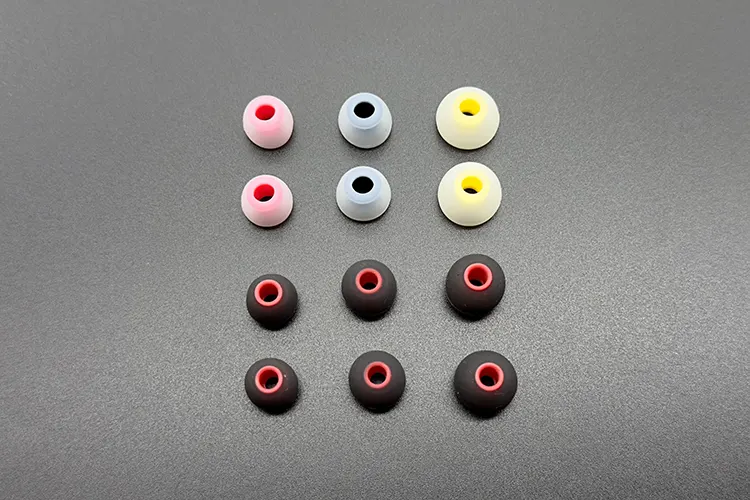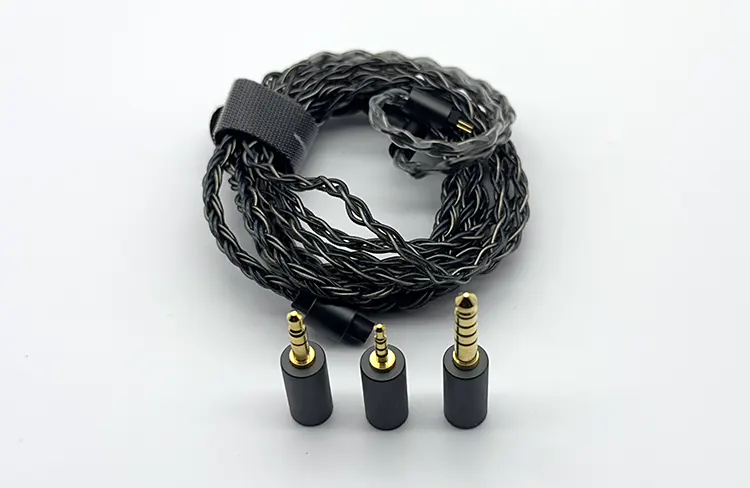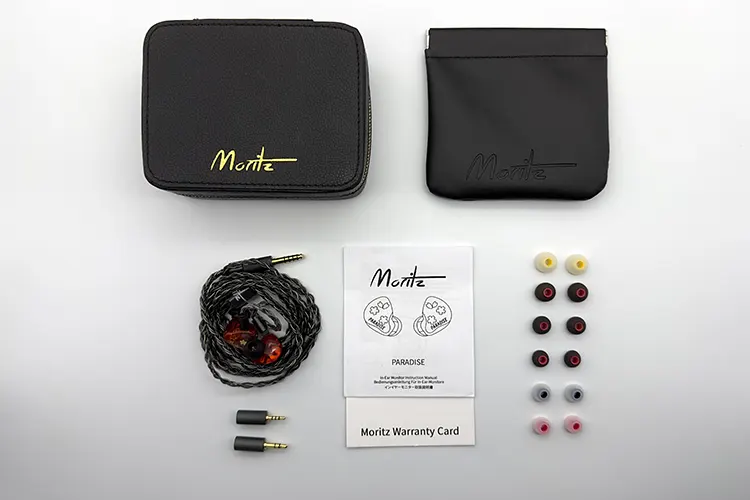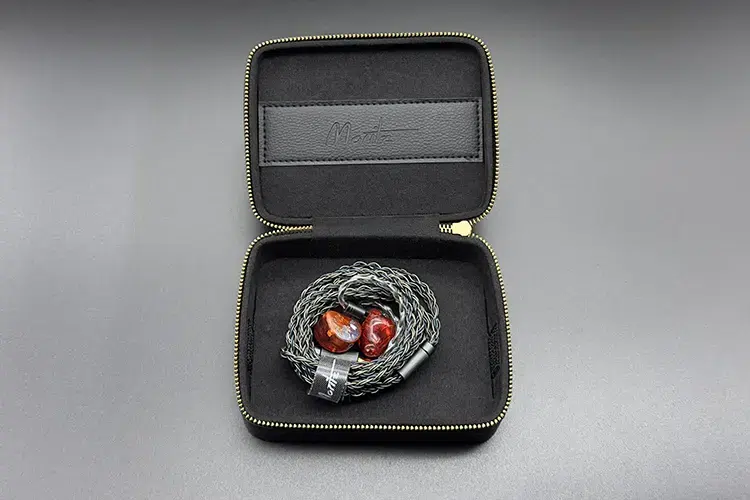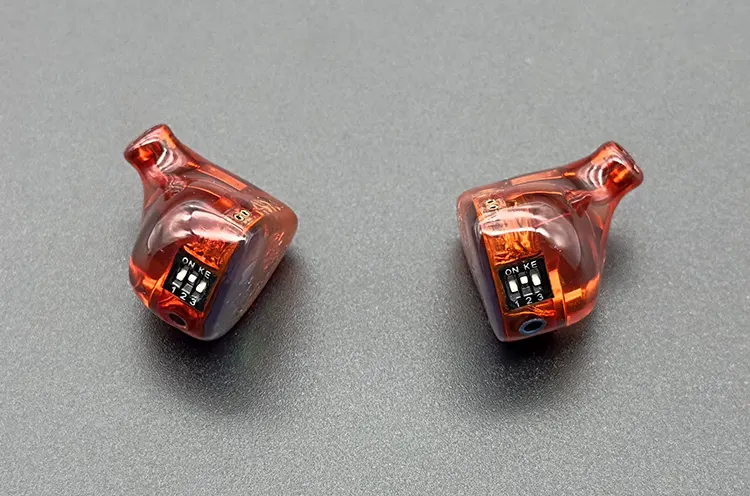In today’s feature, Nihal reviews the Moritz Audio Paradise, a hybrid universal IEM featuring dual dynamic, 4 BA, and 2 bone conduction drivers. It is priced at $729.
Disclaimer: I was sent this sample in exchange for my honest opinion. Headfonics is an independent website with no affiliate links or services. I thank Moritz Audio for their support.
You can click here to learn more about the IEMs we have previously reviewed on Headfonics.
This post follows our current scoring guidelines which you can read in more detail here.
Moritz Audio is a relatively new, boutique In-Ear Monitor (IEM) brand from Hong Kong. Although the people behind it have a background in IEM manufacturing, their previous work isn’t widely known.
Currently, Moritz Audio offers a compact lineup of three mid-fi IEMs that look quite promising at first glance, which piqued our interest in trying out their model, Paradise.
The Paradise stands out with its unique bone conduction hybrid driver configuration and tuning switches allowing three distinct sound profiles.
In this review, I will compare the Paradise to other IEMs such as the THIEAUDIO Hype 10 and the Alpha Omega Ra to see if this intriguing newcomer has something special to offer.
Features
The Paradise IEM showcases a sophisticated driver configuration, featuring eight drivers per side.
This setup includes dual dynamic drivers for the lows, a blend of four balanced armature drivers from Knowles and Sonion for the mids and highs, and dual bone conduction drivers from Sonion.
The bone conduction drivers add an extra layer of vibrancy and physicality, transmitting frequencies through the ear cartilage to enhance the lower to midrange with a tactile quality.
Additionally, the Paradise uses a 4-way crossover and 5-channel distribution network, allowing each driver to operate within its optimal range.
Two channels are dedicated exclusively to the bone conduction drivers, further enriching bass and midrange performance for a more immersive audio experience.
Design
The Paradise IEM has an adorable, compact build that exudes charm. Its resin shells are crafted in a vibrant, transparent orange, giving them a candy-like appearance that I’m careful to keep out of reach of my two-year-old daughter.
The faceplate adds a touch of elegance with shiny, flower-shaped accents and subtle glitter elements, all highlighted by a bluish hue that contrasts beautifully with the orange shells. Overall, it’s a visually appealing IEM with a thoughtful design language.
The IEM has three dip switches, allowing for three distinct tuning options, which I’ll explore further in the sound impressions section. The switches are quite small, so you’ll need a thin tool to toggle them.
Paradise uses a 2-pin 0.78mm connector for compatibility with various cables. The nozzle is slightly shorter but not too small to cause fitting issues. However, finding the perfect ear tip may take some experimentation.
Each shell features two vents: one sits just below the switches, protected by a fine mesh, while the other, located lower on the shell, has a dual-opening design. I suspect this second vent helps manage airflow, which is especially useful for handling the IEM’s bass-heavy profile.
Comfort & Isolation
The shells are on the smaller side, making them comfortable for most users. I had no issues with fit; they sit securely in the ear without protruding much. Compared to the Hype 4 and Oracle MKIII, these shells are noticeably more compact.
Ergonomically, the design is excellent. The lightweight shells feature smooth, rounded curves, providing natural comfort with no sharp edges or pressure points.
I don’t feel any extra pressure on my ear, and once they’re in place, they stay put without causing concern about slipping out.
Isolation is just average. In noisy environments, they do not block out external sounds or conversations effectively, so I tend to look for a quieter spot when using the Paradise.
Even with well-fitting ear tips, isolation is a bit lacking. However, thanks to the multiple vents on the shells, there’s no pressure buildup, and there’s no driver flex either.
Ear Tips
The Paradise comes with six pairs of colorful silicone ear tips, offering two types in three sizes each—small, medium, and large.
One set features a softer flange and a slightly wider bore, while the other set in dark grey has narrower stems. Of the stock options, I found that the softer, medium-sized tips provided the best fit for me.
With the Paradise’s small nozzle, finding a comfortable and secure fit can be a bit of a challenge.
After going through my collection, I discovered that the SpinFit Omni ear tips worked best. Their thick, compact stem offers a snug, stable fit, and the slightly wider bore helps to open up the soundstage nicely. Other tips didn’t quite match the performance and fit that the Omni provides.
Stock Cable
The cable included with the Paradise IEMs feels instantly familiar, resembling those provided with the Oriveti OD200 and OH700VB models.
This eight-wire design is well-braided in a tasteful green and grey, and the soft outer sleeve is a nice touch. With the 0.78mm 2-pin connector and three swappable adapters (4.4mm, 3.5mm, and 2.5mm), it’s set up to work with just about anything.
The adapter barrels, seemingly made of aluminum, use a secure “push-and-pull” mechanism for a stable connection. While the build could be a bit firmer and has a slight tendency to tangle, the cable’s thickness makes it easy to handle.
Notably, it has no microphones, which enhances the listening experience, and its lightweight design adds to the overall comfort. You likely won’t feel the need to switch to another cable.
Packaging & Accessories
The Paradise arrives in a modestly sized, well-thought-out package. The outer black sleeve showcases the brand’s logo alongside a stylish representation of the IEM design.
Sliding off the sleeve reveals a beautifully textured black box with the brand’s name elegantly engraved in gold that enhances its premium feel.
Opening the box, you’re greeted by a spacious leather carry case and an assortment of accessories. Unlike many packaging styles, there’s no foam cutout here, which makes sense given the size of the carry case. The carry case is roomy enough to house the IEMs with the cable securely attached.
Additional accessories, like the ear tips and cable termination adapters, come neatly organized in separate plastic pouches. A nice touch is the inclusion of a leather pouch with a decent amount of storage space, adding both convenience and style to the overall unboxing experience.
The accessories with the Paradise include:
- Carry Case
- Leather Pouch
- Silicone Ear Tips
- 2-pin Cable with multiple adapters
- Pair of IEMs
- Warrant card
Sound Impressions
The following sound impressions of the Moritz Audio Paradise were completed using a mixture of my main source, Lotoo’s Paw Gold Touch, and occasionally the Questyle CMA18P and Earmen Angel DAC/amps. I paired the IEMs with stock cable and SpinFit Omni ear tips, size L.
Summary
Paradise brings a lively V-shaped sound signature to the table, offering a balance across the frequencies with a satisfying emphasis on the bass.
There’s a nice warmth to the overall tone, creating a rich and inviting sound. The midrange feels natural, with decent resolution and clarity, while the treble holds its own, delivering enough details without being overpowered by the bass.
One of the unique touches here is the bone conduction drivers, which add an engaging physicality to the bass and midrange. This tactile feedback enhances depth, making the overall experience more immersive and fun.
Before we dive into the details of Paradise’s sound, it’s important to understand the tuning switches. Paradise offers three distinct sound profiles, adjusted through three tuning switches.
The design here is a bit unconventional: each switch works independently, and only one switch should be activated at a time. If multiple switches are on or all are off, the tuning can sound unbalanced.
Tuning Modes
This unique setup allows you to tailor the sound with three specific modes:
UDD (Texture Mode)
This setting brings out the deepest, most rumbling bass, perfect for satisfying any basshead cravings. In this mode, the bass takes the spotlight, occasionally veiling the midrange, with the treble toned down for a warmer, more subdued presentation.
DUD (Natural Mode)
Known as the “Natural” mode, this is my preferred setting and the one I used for the rest of the review. Here, the bass impact is scaled back, allowing the midrange to shine more fully, while the treble feels airier and more detailed. This mode strikes a comfortable balance that many will find pleasing.
DDU (Vocal Mode)
True to its name, this setting brings vocals and midrange elements to the forefront. The bass is more reserved of all modes but still present, while the midrange gains a bit of a neutral, clean character.
The treble remains clean and energetic without much interference from the bass, creating a well-rounded, engaging listening experience.
We’ll explore these modes further as we dive into each frequency range below. I also tried unconventional combinations, like DDD or UUU, but the sound became noticeably off balance, confirming that these three settings are indeed the intended tunings.
Unless otherwise specified, all descriptions provided are based on the Natural Mode.
Bass
Thanks to the innovative bone conduction drivers, the bass isn’t just heard; it’s felt, bringing a sense of physicality and impact that adds an addictive “fun factor” to your listening experience.
When it comes to bass quantity, it all hinges on the tuning mode you select. In the Texture mode, for instance, you’re treated to a robust and engaging bass that delivers deep, rumbling sub-bass along with impactful mid-bass.
When compared to some other bass-heavy contenders like the Alpha Omega Ra and THIEAUDIO Hype 10, the Texture mode offers a more pronounced bass presence.
While this bass may not be the most refined it excels in control. It avoids overshadowing the higher frequency ranges much, maintaining a clean midrange and treble.
It feels as though the bass is engaged from a different dimension; it surrounds the midrange and treble without fully blending into them.
You can sense a reverberation that adds depth, creating an intense, head-filling rumble that resonates deep within you. The bass decay is moderate, giving it a lingering, satisfying rumble.
I find the bass to be more than sufficient on the Texture mode, often switching to other tuning modes just to avoid an overload of the bass sensation.
The Texture mode delivers the heaviest bass impact but does not meet all criteria. The texture and layering can occasionally feel off due to the dominant bass presence.
However, in the Natural and Vocal modes, the texture and layering improve, allowing for better discernment of basslines from different instruments as the bass impact becomes more subdued, particularly in the sub-bass.
The mid-bass also decreases from Texture to Natural to Vocal, but the reduction in sub-bass impact allows the mid-bass to shine. Even in Vocal mode, the bass remains quite impactful without being overemphasized.
Midrange
The midrange exhibits a typical V-shaped signature, albeit not rigidly defined. It tends to take a backseat and may feel slightly recessed, depending on the selected mode and the bass presence.
However, the midrange impresses with its rich, natural sound, emphasizing resolution and clarity. Instruments and vocals are rendered with decent clarity, a quality often lacking in many V-shaped bass-heavy IEMs.
Even in the Texture mode, where bass dominates, the midrange retains ample space, thanks to a thoughtfully designed bass response. This results in decent instrument separation, allowing vocals and midrange instruments to shine through beautifully without a restrained feeling.
In Vocal mode, the midrange receives the most favorable treatment. Here, it displays a forwardness and enhanced presence, while the lower midrange is less thick than other modes.
Vocals gain a pleasing texture and weight, feeling closer to the listener and taking center stage. Subtle details and aspects that can be overshadowed in Texture mode are more pronounced.
The upper midrange is nicely extended and detailed, which helps female vocals achieve additional clarity and airiness. This mode also imparts a touch of sweetness to the midrange.
Considering the bass-dominating and fun tuning, it might seem overly critical to highlight flaws in the midrange. It delivers a nice performance without significant compromises.
While a bit more forwardness and a more balanced approach—reducing the lower midrange thickness while adding body to the upper midrange—would be ideal, the current configuration still impresses.
Treble
It’s no surprise that, much like the midrange, the treble also takes a backseat in this IEM. As with many bass-heavy models, the treble is slightly compromised and dialed back to create a harmonious balance with the elevated bass, avoiding harsh contrasts. Fortunately, this doesn’t lead to a gloomy or overly dark sound signature.
While the treble maintains a decent presence, it may feel somewhat recessed, contributing to a laid-back character that complements the robust bass.
The tuning prioritizes smoothness, effectively minimizing harshness or sibilance, which results in a relaxed upper range. Terms like “bright,” “sparkly,” or “airy” don’t quite fit this treble definition.
In the Vocal mode, the treble shines the brightest, as it experiences the least bass impact. However, it still lacks that airy, intricate quality. There’s enough clarity to appreciate the sound, and the treble is clean and crisp without becoming sharp.
Nevertheless, the notes remain thin and tend to dissipate quickly, often blending into one another, making it challenging to distinguish individual treble notes. Both the Vocal and the Natural modes share a similar treble profile.
Staging & Dynamics
Paradise offers impressive technical performance, though it may not be class-leading. It excels in several areas and complements its bass-heavy tuning, which I consider a significant advantage.
The soundstage has average width but boasts a pleasing depth, creating a holographic feel that, while not overly spacious, is still engaging. Imaging is well executed, lending a precise quality to the soundstage.
Instruments are beautifully distributed across the mix, providing a nice sense of space and separation. Vocals are given appropriate room when they appear, and layering is handled effectively, ensuring that even in complex tracks, instruments remain distinct.
In terms of detail retrieval, Paradise performs admirably, uncovering micro-details and nuances that contribute to a realistic and faithful representation of the music.
The resolution is about average, which aligns with my expectations. However, there’s a notable clarity and crispness in the tuning that many bass-heavy sets often lack. Overall, you won’t find yourself missing much from Paradise.
Click on page 2 below for my recommended pairings and selected comparisons.


